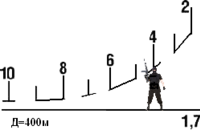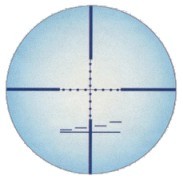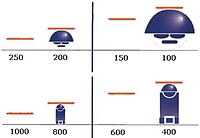133:
171:
186:
25:
216:
with marks of a known angular spacing, the principle of similar triangles can be used to find either the distance to objects of known size or the size of objects at a known distance. In either case, the known parameter is used, in conjunction with the angular measurement, to derive the length of the
391:
This system is sufficiently precise for locating topographic details such as rivers, bridges, buildings, and roads when an accuracy of 1/500 (0.2%, 2000ppm) is acceptable. Stadia readings are also used to provide repeated, independent observations for improved accuracy and to provide error checking
288:
In practice, it can be seen that rough approximations may be made with a right triangle whose base (b) is equal to the distance of the 'rangefinder' from the eye; with the aperture (a) being the hole through which the target is sighted – the apex of this triangle being on the surface of the user's
284:
greatly simplify the trigonometry, enabling one to scale objects measured in milliradians through a telescope by a factor of 1000 for distance or height. An object 5 meters high, for example, will cover 1 mrad at 5000 meters, or 5 mrad at 1000 meters, or 25 mrad at 200 meters. Since the radian
36:
123:
methods. Although much easier to use, electronic rangefinders can give away the shooter's position to a well-equipped adversary, and the need for accurate range estimation has existed for much longer than electronic rangefinders small and rugged enough to be suitable for military use.
379:
The instrument must be level for this method to work directly. If the instrument line of sight is inclined relative to the staff, the horizontal and vertical distance components must be determined. Some instruments have additional
371:
An instrument equipped for stadia work has two horizontal stadia marks spaced equidistant from the center crosshair of the reticle. The interval between stadia marks in most surveying instruments is 10 mrad and gives a
48:
telescopic sight reticle can be used to determine the distance from a 1.70-meter (5 ft 7 in) tall person or object from 200 m (bracket number 2 to the right) to 1,000 m (bracket number 10 to the
150:
282:
403:
instruments do not have stadia lines marked on the reticle. Traditional methods are still used in areas where modern instruments are not common or by aficionados to antique surveying methods.
376:
of 100. The distance between the instrument and a stadia rod can be determined simply by multiplying the measurement between the stadia hairs (known as the stadia interval) by 100.
224:("mil" or "mrad") as the unit of angular measurement. Since a radian is defined as the angle formed when the length of a circular arc equals the radius of the circle, a
399:
The stadia method of distance measurement is primarily historical for surveying purposes, as distance nowadays is mostly measured by electronic or taping methods.
489:
176:• If the helmeted head of a man (≈ 0.25 m tall) fits between the fourth bar and the horizontal line, the man is at approximately 100 meters distance.
228:
is the angle formed when the length of a circular arc equals 1/1000 of the radius of the circle. For telescopic angles, the approximations of
306:
The approximate range of an object one foot (30.48 cm) in height covering roughly 100 milliradians is 10 feet (3.048 m) or:
178:• When the upper part of the body of a man (≈ 1 m tall) fits under the first line, he stands at approximately 400 meters distance.
448:
136:
Table for range estimation showing target sizes, distances and corresponding angular measurements. Angular sizes are given in
285:
expresses a ratio, it is independent of the units used; an object 6 feet high covering 1 mrad will be 6000 feet distant.
231:
388:, provide the value of the horizontal and the vertical measurements as a percentage of the inclined stadia measurement.
68:
468:
292:
For a standard distance from the eye (b) of 28" (71.12 cm); this being the common length of an archer's draw:
458:
320:
The above formula functions for any system of linear measure provided r and h are calculated with the same units.
208:. This means that, for a triangle with a given angle, the ratio of opposite side length to adjacent side length (
484:
205:
209:
132:
83:) which was the typical length of a sports stadium of the time. Stadiametric rangefinding is used for
198:
384:
on a vertical circle to assist with these inclined measurements. These graduated circles, known as
155:
140:(mil), ranges in meters, and target sizes are shown in both in centimeters, millimeters and inches.
381:
170:
149:
190:
8:
329:
197:
weapons of the 1940–70s used stadiametric range estimation based on the average sizes of
120:
310:
Range (r) = approximate height of object (h) × (1000 ÷ aperture in milliradians (a))
159:
88:
368:
of the instrument, providing a known remote height for the distance calculations.
452:
96:
185:
328:
Stadia readings used in surveying can be taken with modern instruments such as
73:
364:. The stadia rod has measurements written on it that can be read through the
478:
400:
313:
r = h(1000/a) → where r and h are identical units, and a is in milliradians.
417:
412:
356:
346:
341:
337:
225:
221:
137:
422:
333:
104:
465:— demonstrates stadiametric rangefinding in an anti-tank weapon sight
393:
365:
112:
84:
64:
194:
116:
100:
111:, but in many professional applications it is being replaced with
107:
and other optics. It is still widely used in long-range military
361:
213:
92:
316:
r = h/a → where r and h are identical units, and a is in radians
44:: The stadiametric rangefinder in the bottom-left corner of the
35:
108:
296:
28" × 1 milliradian ≈ 0.028" (0.071 cm) -- stadia factor 1000
45:
24:
16:
Technique of measuring distances with a telescopic instrument
79:
299:
10 milliradians ≈ 0.280" (0.711 cm) -- stadia factor x 100
302:
100 milliradians ≈ 2.80" (7.112 cm) -- stadia factor x10
234:
277:{\displaystyle \sin(\alpha )=\tan(\alpha )=\alpha }
276:
204:The stadia method is based upon the principle of
476:
63:, is a technique of measuring distances with a
344:. When using the stadia measuring method, a
490:Length, distance, or range measuring devices
463:US Army FM 23-11: 90mm Recoilless Rifle, M67
438:, McGraw-Hill Book Company, 1966 LC 64–66263
193:, correctly ranging a tank at 275 m range.
434:Raymond Davis, Francis Foote, Joe Kelly,
220:Stadiametric rangefinding often uses the
184:
131:
354:is held so that it appears between two
477:
13:
469:Mils / MOA and the Range Equations
14:
501:
442:
169:
148:
34:
23:
67:. The term stadia comes from a
436:Surveying, Theory and Practice
265:
259:
247:
241:
42:Soldier observed at 400 m
1:
428:
455: (archived May 20, 2013)
360:visible on the instrument's
323:
127:
7:
406:
212:) is constant. By using a
10:
506:
199:armoured fighting vehicles
77:(equal to 600 Greek feet,
189:Targeting reticle of the
57:Stadiametric rangefinding
374:stadia interval factor
278:
201:
141:
485:Measuring instruments
279:
188:
135:
65:telescopic instrument
392:against blunders in
338:plane-table alidades
232:
191:M67 recoilless rifle
459:"Technique of Fire"
274:
202:
142:
121:laser rangefinding
103:, as well as some
471:by Robert Simeone
206:similar triangles
160:telescopic sights
89:telescopic sights
497:
283:
281:
280:
275:
173:
152:
97:artillery pieces
38:
27:
505:
504:
500:
499:
498:
496:
495:
494:
475:
474:
453:Wayback Machine
445:
431:
409:
326:
233:
230:
229:
183:
182:
181:
180:
179:
177:
174:
165:
164:
163:
156:Mil-dot reticle
153:
130:
54:
53:
52:
51:
50:
39:
30:
29:
28:
17:
12:
11:
5:
503:
493:
492:
487:
473:
472:
466:
456:
444:
443:External links
441:
440:
439:
430:
427:
426:
425:
420:
415:
408:
405:
386:stadia circles
325:
322:
318:
317:
314:
311:
304:
303:
300:
297:
273:
270:
267:
264:
261:
258:
255:
252:
249:
246:
243:
240:
237:
175:
168:
167:
166:
154:
147:
146:
145:
144:
143:
129:
126:
40:
33:
32:
31:
22:
21:
20:
19:
18:
15:
9:
6:
4:
3:
2:
502:
491:
488:
486:
483:
482:
480:
470:
467:
464:
460:
457:
454:
450:
447:
446:
437:
433:
432:
424:
421:
419:
416:
414:
411:
410:
404:
402:
401:Total station
397:
395:
389:
387:
383:
377:
375:
369:
367:
363:
359:
358:
353:
349:
348:
343:
339:
335:
331:
321:
315:
312:
309:
308:
307:
301:
298:
295:
294:
293:
290:
286:
271:
268:
262:
256:
253:
250:
244:
238:
235:
227:
223:
218:
215:
211:
207:
200:
196:
192:
187:
172:
161:
157:
151:
139:
134:
125:
122:
118:
114:
110:
106:
102:
98:
94:
90:
86:
82:
81:
76:
75:
70:
66:
62:
61:stadia method
58:
47:
43:
37:
26:
462:
435:
398:
390:
385:
378:
373:
370:
357:stadia marks
355:
351:
345:
327:
319:
305:
291:
287:
219:
217:other side.
203:
138:milliradians
78:
72:
60:
56:
55:
41:
461:, Ch. 5 of
418:Rangefinder
413:Milliradian
382:graduations
347:level staff
334:theodolites
226:milliradian
222:milliradian
158:as used in
87:and in the
479:Categories
449:The Stadia
429:References
423:Stadimeter
352:stadia rod
105:binoculars
71:of length
69:Greek unit
394:levelling
366:telescope
324:Surveying
272:α
263:α
257:
245:α
239:
128:Principle
113:microwave
101:tank guns
85:surveying
59:, or the
407:See also
330:transits
195:Antitank
117:infrared
93:firearms
451:at the
362:reticle
214:reticle
210:tangent
109:sniping
74:Stadion
342:levels
49:left).
289:eye.
119:, or
99:, or
46:PSO-1
340:and
80:pous
350:or
254:tan
236:sin
91:of
481::
396:.
336:,
332:,
115:,
95:,
269:=
266:)
260:(
251:=
248:)
242:(
162:.
Text is available under the Creative Commons Attribution-ShareAlike License. Additional terms may apply.





